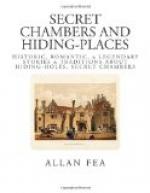After the discovery of the Gunpowder Plot, “Little John” and his master, Father Garnet, were arrested at Hindlip Hall, Worcestershire, from information given to the Government by Catesby’s servant Bates. Cecil, who was well aware of Owen’s skill in constructing hiding-places, wrote exultingly: “Great joy was caused all through the kingdom by the arrest of Owen, knowing his skill in constructing hiding-places, and the innumerable number of these dark holes which he had schemed for hiding priests throughout the kingdom.” He hoped that “great booty of priests” might be taken in consequence of the secrets Owen would be made to reveal, and directed that first he should “be coaxed if he be willing to contract for his life,” but that “the secret is to be wrung from him.” The horrors of the rack, however, failed in its purpose. His terrible death is thus briefly recorded by the Governor of the Tower at that time: “The man is dead—he died in our hands”; and perhaps it is as well the ghastly details did not transpire in his report.
The curious old mansion Hindlip Hall (pulled down in the early part of the last century) was erected in 1572 by John Abingdon, or Habington, whose son Thomas (the brother-in-law of Lord Monteagle) was deeply involved in the numerous plots against the reformed religion. A long imprisonment in the Tower for his futile efforts to set Mary Queen of Scots at liberty, far from curing the dangerous schemes of this zealous partisan of the luckless Stuart heroine, only kept him out of mischief for a time. No sooner had he obtained his freedom than he set his mind to work to turn his house in Worcestershire into a harbour of refuge for the followers of the older rites. In the quaint irregularities of the masonry free scope was given to “Little John’s” ingenuity; indeed, there is every proof that some of his masterpieces were constructed here. A few years before the “Powder Plot” was discovered, it was a hanging matter for a priest to be caught celebrating the Mass. Yet with the facilities at Hindlip he might do so with comfort, with every assurance that he had the means of evading the law. The walls of the mansion were literally riddled with secret chambers and passages. There was little fear of being run to earth with hidden exits everywhere. Wainscoting, solid brickwork, or stone hearth were equally accommodating, and would swallow up fugitives wholesale, and close over them, to “Open, Sesame!” again only at the hider’s pleasure.
CHAPTER II
HINDLIP HALL
The capture of Father Garnet and “Little John” with two others, Hall and Chambers, at Hindlip, as detailed in a curious manuscript in the British Museum, gives us an insight into the search-proof merits of Abingdon’s mansion. The document is headed: “A true discovery of the service performed at Hindlip, the house of Mr. Thomas Abbingdon, for the apprehension of Mr. Henry Garnet, alias Wolley, provincial of the Jesuits, and other dangerous persons, there found in January last, 1605,” and runs on:—




